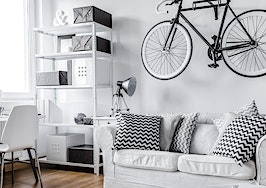- Ivy Lofts offers 65 percent micro-dwellings in 550-unit development.
- Houston B-Cycle and ZipCar will have designated stations on-site.
- Units range from $119,000 to $599,000.
- Re/Max Inner Loop has already sold 21 percent of units.

Jason Franklin
“Intrinsically, when people think of Texas they think of wide-open spaces,” said Jason Franklin, Sales Director at Re/Max Inner Loop, representing Houston‘s micro-dwelling development near the East Corridor. “This will be the largest micro-dwelling in the United States to date, at 550 units.”
He’s talking about the Ivy Lofts, a mixed-use development housing condos with titles like The Tokyo, The New York, The Paris, The London, The Barcelona — and, of course, The Houston.
The Tokyo, for example, offers a living space of approximately 310 square feet, while The Houston sprawls to 1,001.

The Tokyo
Micro-dwellings — and slightly larger
Sitting atop the seven-level parking garage, which features six electric car charging stations, is the residential community.
A micro-dwelling, by definition, is a living space smaller than 500 square feet; technically, only about 65 percent of Ivy Loft units fit that description.
The other units climb from approximately 300 square feet up to just over 1,000 square feet.
Amenities
The first floor features 15,500 square feet of retail space, space that Franklin said would exclusively house local businesses. On multiple levels are gyms, green spaces, outdoor lounging areas, grills, pools, and other amenities.
Houston’s B-Cycle program has agreed to install a bike station on-site, and ZipCar receives special parking spaces.
Franklin said that this site will also be fully automated with AT&T Digital life, which means residents can unlock their doors, dim lights, draw blinds or check cameras in their “Barcelona” or “Houston” (or what-have-you) spread while away, all from their phones.
Appeal to millennials
“The mental shift taking place socially by the 26-to-35-year-olds right now is so far advanced than what we’re ready for,” Franklin said. “They aren’t looking for the worldly possessions that we were looking for. They are traveling. They are saving. They are moving. They are experiencing life on a different level. They are living more socially.”
He added that outside of New York, the only other city where he’s seen micro-dwelling development on this scale was in Vancouver, where he traveled during research and development.
300 square feet at a time
“The easiest way to make people understand this is that we as people only [inhabit] 300 square feet at a time,” he explained, adding that the typical living room, master bedroom, or kitchen is in the 300- to 400-square-feet range. “What if I can offer a space that turns your kitchen into your bedroom, bedroom into your living room, and living room into your kitchen, as needed?”
Franklin, 41, is bringing a forward-thinking approach, examining the market through the lens of his own home. “I’m raising millennials in my home, well, pre–millennials,” he explained. “The people, the movers and shakers that are in charge of the real estate world right now, are ready for the mental shift that the millennials are bringing in the same manner that our grandparents were ready for the ’60s.”
“The movers and shakers that are in charge of the real estate world right now are ready for the mental shift that the millennials are bringing.” – Jason Franklin
The affordability (The Tokyo starts at $119,000) and practicality (you can grab a beer from the couch) is something Franklin is seeing millennials move toward, especially in Houston, where owning is becoming more affordable than renting. He sees that they are learning from their parents’ experience — not mistakes — and evolving the same principles to fit their social lifestyle.
“Really, what it speaks to is a number of people…seeing the inordinate amount of stress and pressure that their parents carried by having the car, having the three/two/two with a pool and palm trees,” Franklin said. “They think, ‘I want a home that doesn’t own me.'”









